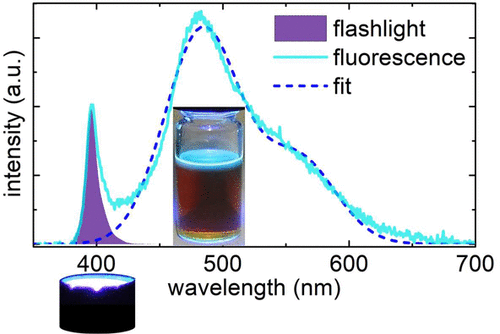当前位置:
X-MOL 学术
›
J. Chem. Educ.
›
论文详情
Our official English website, www.x-mol.net, welcomes your feedback! (Note: you will need to create a separate account there.)
Carbon Nanoparticles from Lactose and Baking Soda: Light Absorption and Fluorescence
Journal of Chemical Education ( IF 3 ) Pub Date : 2019-11-27 , DOI: 10.1021/acs.jchemed.9b00823 Benedikt Klobes 1 , Christine Koch 1
Journal of Chemical Education ( IF 3 ) Pub Date : 2019-11-27 , DOI: 10.1021/acs.jchemed.9b00823 Benedikt Klobes 1 , Christine Koch 1
Affiliation

|
Fluorescent carbon nanoparticles were prepared using an α-lactose and baking soda based colloidal synthesis route. The existence of the synthesized carbon nanoparticles (CNPs) was detected using the Tyndall effect while their optical properties were investigated by ultraviolet–visible absorption and fluorescence spectroscopy. The CNPs exhibit characteristic light absorption around 310 nm and distinct fluorescence within the interval from 450 to 600 nm upon irradiation with ultraviolet light. Due to the simple and fail-proof synthesis, this activity is well-suited for a hands-on introduction of nanoparticle synthesis and optical phenomena such as fluorescence to chemistry freshman and high school students.
中文翻译:

乳糖和小苏打中的碳纳米颗粒:光吸收和荧光
使用基于α-乳糖和小苏打的胶体合成路线制备了荧光碳纳米粒子。使用廷德尔效应检测了合成的碳纳米颗粒(CNP)的存在,同时通过紫外可见吸收和荧光光谱研究了它们的光学性质。当用紫外线照射时,CNP在310 nm附近表现出特征性的光吸收,并在450至600 nm的区间内表现出明显的荧光。由于简单而可靠的合成,该活动非常适合向化学新生和高中生进行纳米粒子合成和光学现象(如荧光)的动手实践。
更新日期:2019-11-28
中文翻译:

乳糖和小苏打中的碳纳米颗粒:光吸收和荧光
使用基于α-乳糖和小苏打的胶体合成路线制备了荧光碳纳米粒子。使用廷德尔效应检测了合成的碳纳米颗粒(CNP)的存在,同时通过紫外可见吸收和荧光光谱研究了它们的光学性质。当用紫外线照射时,CNP在310 nm附近表现出特征性的光吸收,并在450至600 nm的区间内表现出明显的荧光。由于简单而可靠的合成,该活动非常适合向化学新生和高中生进行纳米粒子合成和光学现象(如荧光)的动手实践。



























 京公网安备 11010802027423号
京公网安备 11010802027423号